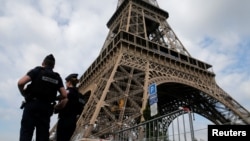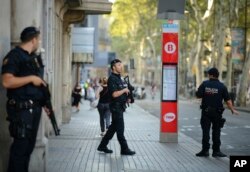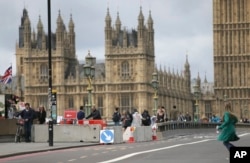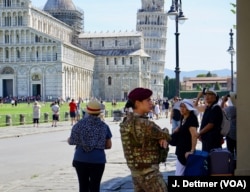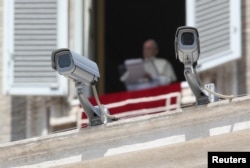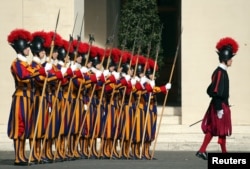European governments are once again scrambling to come up with new security measures aimed at making it more difficult for extremists using cars, knives and other low-tech weapons to attack civilians in city centers and near landmark sites, monuments and tourist attractions.
The car-ramming attack earlier in August in Barcelona, in which a van mowed down pedestrians, followed soon after by a stabbing frenzy in the Finnish town of Turku, has prompted national and municipal authorities across the continent to review security measures and to erect concrete barriers to hinder extremists from plowing into shoppers and tourists.
Cost, aesthetics concerns
But analysts say many city authorities remain reluctant to introduce "Israeli-style" security — and costs and aesthetics are being weighed, too. “We can’t fill up Barcelona with bollards,” Joaquim Forn, who oversees home affairs in Barcelona’s Catalonia region, told Spanish radio recently.
However, slowly but surely, after each attack, reluctance is giving way and manufacturers of bollards and security barriers say there’s been an increase in orders in recent weeks.
Some municipal authorities, including in the British city of Birmingham, are using water-features and trees to provide some protection.
Europe has experienced a dozen car-ramming attacks so far this year.
New security measures in London
British authorities are considering erecting a boom in the River Thames to defend the House of Commons from a boat-borne attack. The barrier has been recommended by police chiefs after a security drill showed how easy it would be for extremists to gain riverside access to the Palace of Westminster, kill lawmakers socializing on terraces overlooking the Thames and gain access to the debating chambers of both the Commons and the House of Lords.
Last March, a British Muslim convert, Khalid Masood, mowed down pedestrians on Westminster Bridge before stabbing to death a policeman in the grounds of the Palace of Westminster, where he was shot dead. The London mayor has called for cars to be banned from Parliament Square altogether.
A spokesman for the Palace of Westminster said in a statement: “We work closely with the police, security services and others to ensure our security measures are effective and meet whatever level of risk parliament faces.”
London police mounted an unprecedented security effort over the weekend and Monday to protect the Notting Hill carnival, deploying for the first time concrete and metal barriers at Europe’s biggest street party, which was attended by a million revelers over three days. Security arrangements included 8000 police officers patrolling on foot. The carnival kicked off 24 hours after a man drove at police outside Buckingham Palace and then lashed at them with a sword.
Vatican challenge
In Rome, authorities have erected more barriers around landmark sites to prevent car-ramming. But aesthetics are being hotly debated, with municipal politicians and residents in the historic center opposing unsightly obstructions.
Anti-terror flower pots were installed Monday outside the presidential Quirinale Palace. Similar pots, ordered in the wake of the Barcelona van terror attack, have been installed already in the Roman Forum with more planned for parts of Via del Corso and Piazza del Popolo.
Although Italy is the one major European country not to have experienced a jihadist attack, concerns are mounting that it’s only a matter of time before there will be one.
The Islamic State terror group has threatened frequently to attack the Italian capital — and the Vatican in particular.
On Saturday, Pope Francis’s top aide reacted to an IS video posted online last week calling on "lone wolves" to drive cars into crowds around the Vatican, saying “one cannot avoid worrying.”
But Italian Cardinal Pietro Parolin told reporters in the city of Rimini that no particular new security measures are being put in place in the Vatican as a direct result of that video, which showed a terrorist tearing an image of Francis.
Paloma García Ovejero, the pope’s deputy spokesperson, said last week: “We haven’t raised the security measures because the controls are already very high.”
Speaking to reporters, she added: “St. Peter’s Square, as pilgrims and tourists can ascertain, is always very well protected.”
Protection was dramatically increased around the Vatican after last year’s attacks in Paris with the main artery leading to the square closed to traffic. Heavy pots with palm trees were placed on side streets, and a military and Italian police presence is visible around the Vatican, which is protected on church territory by Pontifical Swiss Guards and the 130-strong Corpo della Gendarmeria, which includes a Rapid Intervention Group and an anti-sabotage unit.
The Swiss Guards, who are charged with the Pope’s personal safety, have recently been going through re-training, focusing on marksmanship, in Ticino, an Italian-speaking region in southern Switzerland.
Last week, Swiss Guard Commander Christoph Graf said that “it may only be a matter of time” before extremists launch an attack in Rome.”
On Monday, Italy deported a 37-year-old Moroccan, the third Moroccan this month, who had been flagged as a high security risk.
Many churches across Europe are introducing new security measures to try to decrease the risk of attack and casualties. In Cologne, Germany, authorities have placed barricades made up of huge stones around the perimeter of the historic Domplatte cathedral.




